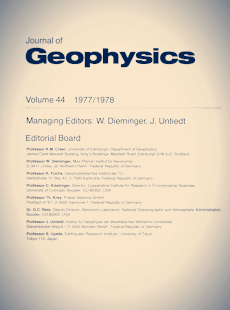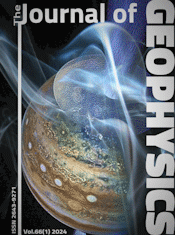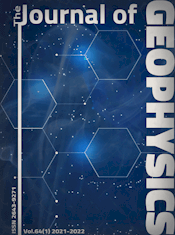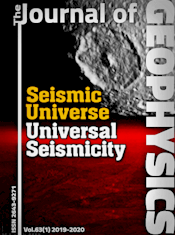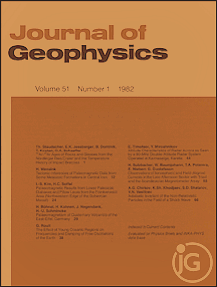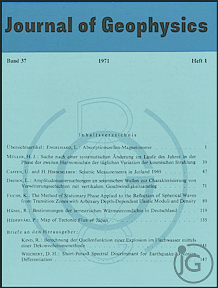Parameters of the auroral electrojet from magnetic variations along a meridian
Article Sidebar
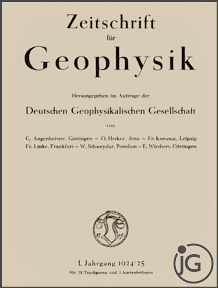
Vols. 1-18 (1924-1944), ISSN 0044-2801
Main Article Content
Abstract
The parameters of the auroral electrojet are described by using an ionospheric sheet current model. Data from a line of magnetometers between 62 and 67 degrees magnetic latitude are the input for the computation of the parameters during electrojet activity. The parameters are depicted in the parameter-time diagram which furnishes mainly the following information:
1. Applicability of the two dimensional current model.
2. Latitudinal extent of the electrojets as a function of time.
3. Location of centre of the current as a function of time.
4. Current flow direction.
Two case studies are carried out. The first comprises DMSP (Defense Meteorological Satellite Program) data, the second makes use of data collected simultaneously by the Scandinavian Twin Auroral Radar Experiment (STARE). The results of the parameter-time diagram and the DMSP as well as the STARE data are in good agreement.
 ARK: https://n2t.net/ark:/88439/y059691
ARK: https://n2t.net/ark:/88439/y059691
Permalink: https://geophysicsjournal.com/article/257
Article Details
References
Bostrom, R. (1971) The magnetic field of three-dimensional magnetospheric model current systems and currents induced in the ground. Acta Polytechnica Scandinavica, PH 77. The Royal Swedish Academy of Engineering Sciences, Stockholm
Brekke, A., Doupnik, J.R., Banks, P.M. (1974) Incoherent scatter measurements of E region conductivities and currents in the auroral zone. J. Geophys. Res. 79:3773-3790
Czechowsky, P. (1971) Calculation of an equivalent current system in the polar E-region. Radio Sci. 6:247-253
Forbush, S.E., Casaverde, M. (1961) Equatorial Electrojet in Peru, Publication 620, Department of Terrestrial Magnetism. Carnegie Inst. Washington D.C.
Greenwald, R.A., Weiss, W., Nielsen, E., Thomson, N.R. (1977) STARE: A new radar auroral backscatter experiment in northern Scandinavia, submitted to Radio Sci.
Gustafsson, G. (1970) A revised corrected geomagnetic coordinate system. Ark. Geofys. 5:595-617
Hanser, F.A., Sellers, B., Vancour, R.P. (1973) The real-time determination of ionospheric current parameters during a substorm. J. Geomag. Geoelectr. 25:339-348
Heinrich, H., Reimer, D., Siemann, H. (1970) Investigation of the auroral electrojet. J. Geophys. 36:399-420
Heppner, J.P. (1972) The Harang discontinuity in auroral belt ionospheric currents. Geofysiske Publikasjoner 29:105-120
Kertz, W. (1954) Modelle fur erdmagnetisch induzierte elektrische Strome im Untergrund. Nachr. Akad. Wiss. Gottingen, Math.-phys. Kl. Ila:101-110
Kisabeth, J.L., Rostoker, G. (1971) Development of the polar electrojet during polar magnetic substorms. J. Geophys. Res. 76:6815-6828
Kisabeth, J.L., Rostoker, G. (1973) Current flow in auroral loops and surges inferred from ground-based magnetic observations. J. Geophys. Res. 78:5573-5584
Kisabeth, J.L., Rostoker, G. (1974) The expansive phase of magneto-spheric substorms: 1. Development of the auroral electrojets and auroral arc configuration during a substorm. J. Geophys. Res. 79:972-984
Kuppers, F., Untiedt, J., Baumjohann, W. (1978) A two-dimensional array for ground-based observations of auroral zone electric currents during the IMS, submitted to J. Geophys.
Mareschal, M. (1976) On the problem of simulating the Earth's induction effects in modeling polar magnetic substorms. Rev. Geophys. Space Phys. 14:403-409
McNish, A.G. (1938) Heights of electric currents near the auroral zone, Terr. Magn. Atmos. Electr. 43:67-75
Montbriand, L.E. (1970) A simple method for calculating the local time of corrected geomagnetic midnight. J. Geophys. Res. 75:5634-5636
Rostoker, G., Kisabeth, J.L. (1973) Response of the polar electrojets in the evening sector to polar magnetic substorms. J. Geophys. Res. 78:5559-5584
Rostoker, G., Kisabeth, J.L., Sharp, R.D., Shelley, E.G. (1975) The expansive phase of magnetospheric subtorms: 2. The response at synchronous altitude of particles of different energy ranges. J. Geophys. Res. 80:3557-3570
Wiens, R.G., Rostoker, G. (1975) Characteristics of the development of the westward electrojet during the expansive phase of magnetospheric substorms. J. Geophys. Res. 80:2109-2128
Zaitzev, A.N., Bostrom, R. (1971) On methods of graphical displaying of polar magnetic disturbances. Planet. Space Sci. 19:643-649
Zmuda, A.J., Martin, J.H., Heuring, F.T. (1966) Transverse magnetic disturbances at 1100 kilometers in the auroral region. J. Geophys. Res. 71:5033-5045


